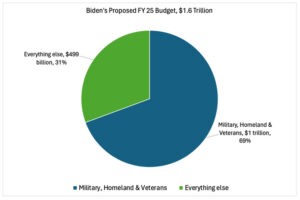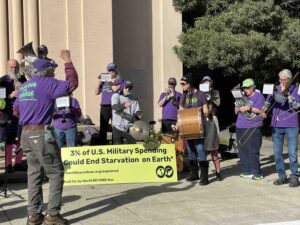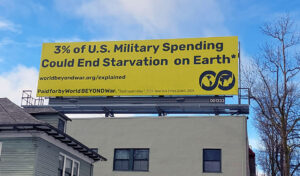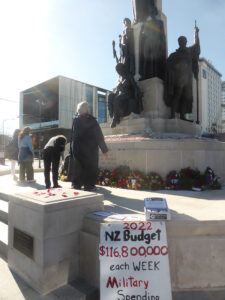It’s common in the United States to hear supporters of war and of military spending, including numerous Congress Members, refer to military spending as a jobs program. How this assertion sounds to victims of the war is worth considering. So is the fact that it is a false assertion on its own terms.
It is common to think that, because many people have jobs in the war industry, spending on war and preparations for war benefits an economy. In reality, spending those same dollars on peaceful industries, on education, on infrastructure, or even on tax cuts for working people would produce more jobs and in most cases better paying jobs — with enough savings to help everyone make the transition from war work to peace work.
Rare cuts in certain areas to the U.S. military have not produced the economic damage forecast by the weapons companies.
Military spending is worse than nothing economically.
War has a huge direct financial cost, the vast majority of which is in funds spent on the preparation for war — or what’s thought of as ordinary, non-war military spending. Very roughly, the world spends $2 trillion every year on militarism, of which the United States spends about half, or $1 trillion. This U.S. spending also accounts for roughly half of the U.S. government’s discretionary budget each year and is distributed through several departments and agencies. Much of the rest of world spending is by members of NATO and other allies of the United States, although China ranks second in the world.
Not every well-known measure of military spending accurately conveys the reality. For example, the Global Peace Index (GPI) ranks the United States near the peaceful end of the scale on the factor of military spending. It accomplishes this feat through two tricks. First, the GPI lumps the majority of the world’s nations all the way at the extreme peaceful end of the spectrum rather than distributing them evenly.
Second, the GPI treats military spending as a percentage of gross domestic product (GDP) or the size of an economy. This suggests that a rich country with a huge military can be more peaceful than a poor country with a small military. This is not just an academic question, as think tanks in Washington urge spending a higher percentage of GDP on the military, exactly as if one should invest more in warfare whenever possible, without waiting for a defensive need. President Trump has urged NATO nations to spend more on militarism using the same argument.
In contrast to the GPI, the Stockholm International Peace Research Institute (SIPRI) lists the United States as the top military spender in the world, measured in dollars spent. In fact, according to SIPRI, the United States spends as much on war and war preparation as most of the rest of the world combined. The truth may be more dramatic still. SIPRI says U.S. military spending in 2011 was $711 billion. Chris Hellman of the National Priorities Project says it was $1,200 billion, or $1.2 trillion. The difference comes from including military spending found in every department of the government, not just “Defense,” but also Homeland Security, State, Energy, the U.S. Agency for International Development, the Central Intelligence Agency, the National Security Agency, the Veterans Administration, interest on war debts, etc. There’s no way to do an apples-to-apples comparison to other nations without accurate credible information on each nation’s total military spending, but it is extremely safe to assume that no other nation on earth is spending $500 billion more than is listed for it in the SIPRI rankings.
While North Korea almost certainly spends a much higher percentage of its gross domestic product on war preparations than the United States does, it almost certainly spends less than 1 percent what the United States spends.
Damage done:
War and violence cause trillions of dollars worth of destruction each year. The costs to the aggressor, enormous as they are, can be small in comparison to those of the nation attacked. For example, Iraq’s society and infrastructure have been destroyed. There is extensive environmental damage, a refugee crisis, and violence lasting well beyond the war. The financial costs of all the buildings and institutions and homes and schools and hospitals and energy systems destroyed is almost immeasurable.
Indirect Expenses:
Wars can cost even an aggressor nation that fights wars far from its shores twise as much in indirect expenses as in direct expenditures. Economists calculate the U.S. wars on Iraq and Afghanistan have cost, not the $2 trillion spent by the U.S. government, but a total of $6 trillion when indirect expenses are considered, including future care of veterans, interest on debt, impact on fuel costs, lost opportunities, etc. This doesn’t include the much greater cost of the increased base military spending that accompanied those wars, or the indirect costs of that spending, or the environmental damage.
War Spending Increases Inequality:
Military spending diverts public funds into increasingly privatized industries through the least accountable public enterprise and one that is hugely profitable for the owners and directors of the corporations involved. As a result, war spending works to concentrate wealth in a small number of hands, from which a portion of it can be used to corrupt government and further increase or maintain military spending.

Eirene (Peace) bearing Ploutos (Wealth), Roman copy after Greek votive statue by Kephisodoto (ca. 370 BCE).
Recent Articles:











